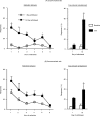Effect of cocaine and sucrose withdrawal period on extinction behavior, cue-induced reinstatement, and protein levels of the dopamine transporter and tyrosine hydroxylase in limbic and cortical areas in rats
- PMID: 12394414
- PMCID: PMC2881302
- DOI: 10.1097/00008877-200209000-00011
Effect of cocaine and sucrose withdrawal period on extinction behavior, cue-induced reinstatement, and protein levels of the dopamine transporter and tyrosine hydroxylase in limbic and cortical areas in rats
Abstract
Lever pressing during tests for resistance to extinction and cue-induced reinstatement of cocaine seeking in rats progressively increases over the first 2 months of withdrawal. In the present report, we investigated the generality of these findings in rats trained to self-administer sucrose, a non-drug reinforcer. We also examined whether the time-dependent changes in cocaine seeking correlate with the levels of the dopamine transporter (DAT) and tyrosine hydroxylase (TH) proteins in the amygdala, nucleus accumbens, prefrontal cortex and orbitofrontal cortex. Rats were trained to self-administer cocaine (0.5 mg/kg/i.v. infusion) or 10% sucrose (0.2 ml/infusion into a liquid drop receptacle) for 10 days (6 h/day); each reward delivery was paired with a tone+light cue. Tests for cocaine seeking were conducted following 1 or 15 reward-free days. On the test day, rats were initially tested for resistance to extinction during 6-7 60-min extinction sessions in the absence of the tone-light cue, until they reached the extinction criterion of less than 15 responses/60 min. Subsequently, rats were tested for cue-induced reinstatement during a 60-min session in which each lever press led to a contingent presentation of the tone-light cue. Lever pressing during the tests for reward seeking was significantly greater on day 15 than on day 1 following withdrawal from both cocaine and sucrose self-administration training. The levels of DAT, but not TH, were greater in the prefrontal cortex of cocaine-trained rats than in sucrose-trained rats on both days 1 and 15 of withdrawal. The levels of DAT and TH in other brain areas were not altered following withdrawal from cocaine or sucrose self-administration. These data suggest that the withdrawal can modulate reward seeking of both drug and non-drug reinforcers, and that alterations in DAT and TH levels in the brain regions examined do not mediate this effect.
Figures


References
-
- Arroyo M, Markou A, Robbins TW, Everitt BJ. Acquisition, maintenance and reinstatement of intravenous cocaine self-administration under a second-order schedule of reinforcement in rats: effects of conditioned cues and continuous access to cocaine. Psychopharmacology. 1998;140:331–344. - PubMed
-
- Arroyo M, Baker WA, Everitt BJ. Cocaine self-administration in rats differentially alters mRNA levels of the monoamine transporters and striatal neuropeptides. Brain Res Mol Brain Res. 2000;83:107–120. - PubMed
-
- Balleine BW, Dickinson A. Goal-directed instrumental action: contingency and incentive learning and their cortical substrates. Neuropharmacology. 1998;37:407–419. - PubMed
-
- Beitner-Johnson D, Nestler EJ. Morphine and cocaine exert common chronic actions on tyrosine hydroxylase in dopaminergic brain reward regions. J Neurochem. 1991;57:344–347. - PubMed
-
- Burchett SA, Bannon MJ. Serotonin, dopamine and norepinephrine transporter mRNAs: heterogeneity of distribution and response to `binge' cocaine administration. Brain Res Mol Brain Res. 1997;49:95–102. - PubMed
Publication types
MeSH terms
Substances
Grants and funding
LinkOut - more resources
Full Text Sources

